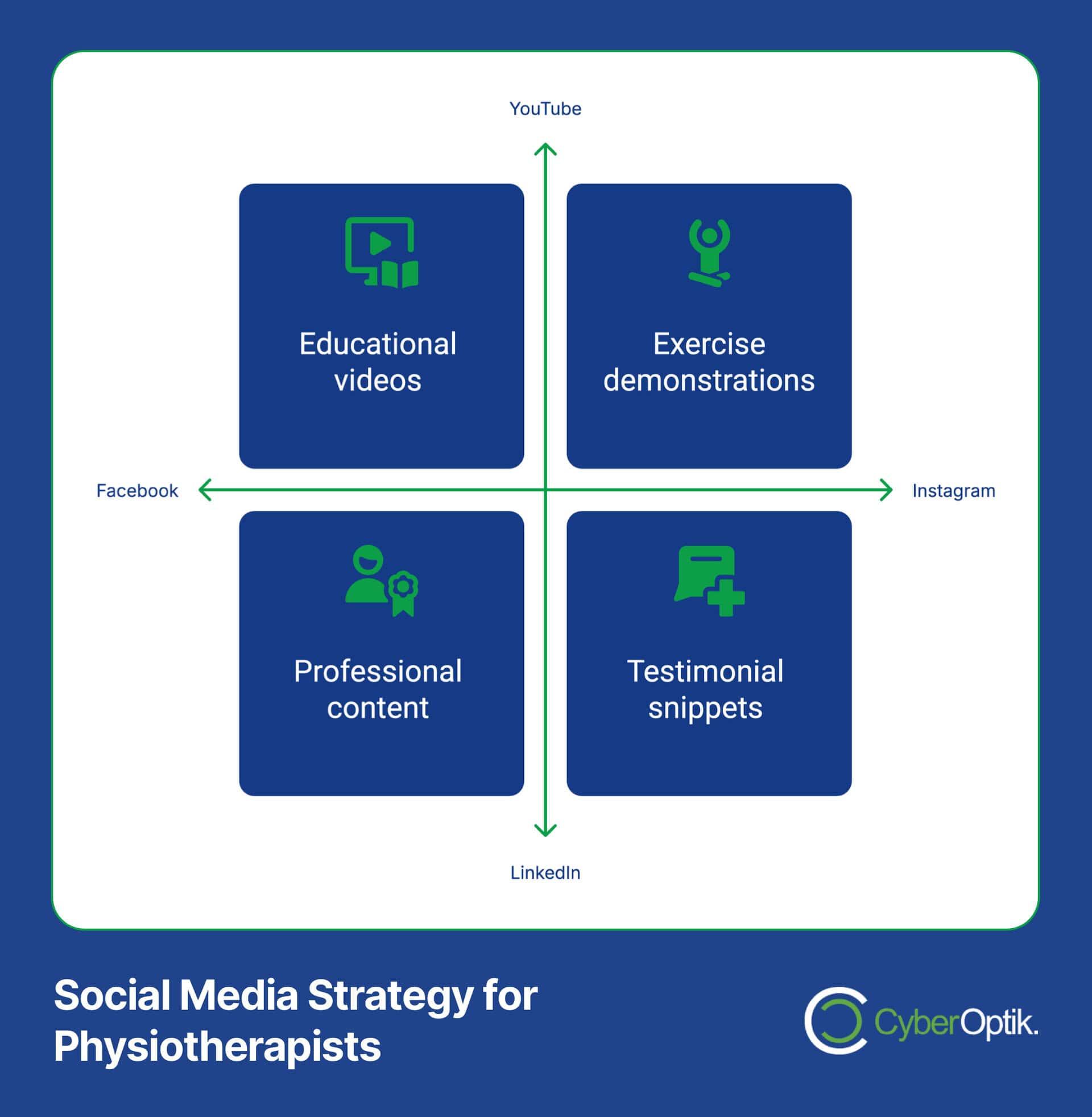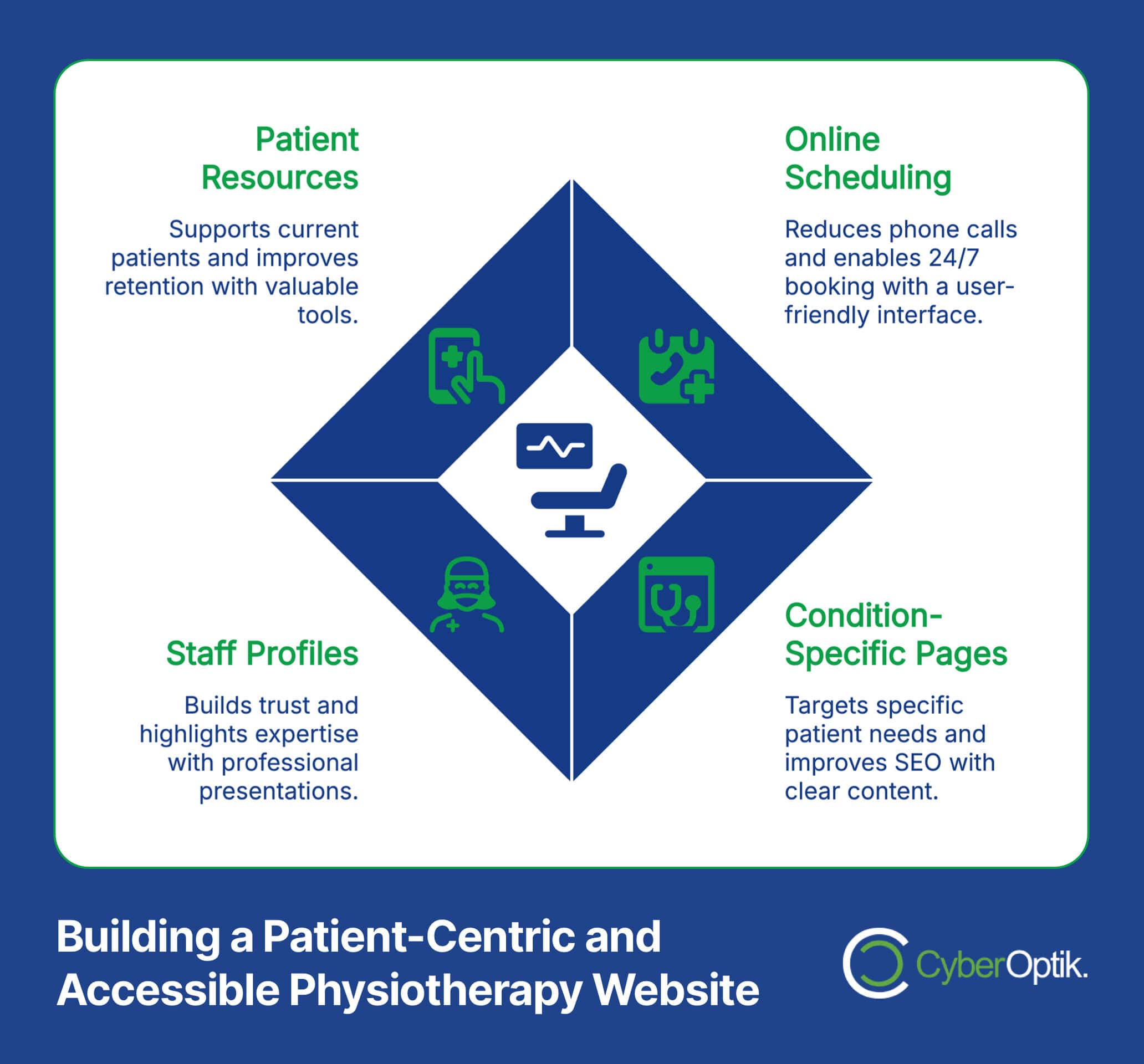Running a successful physiotherapy practice requires more than just clinical expertise. It demands a strategic approach to patient retention and attraction. The healthcare landscape has become increasingly competitive, making effective marketing strategies essential for practice growth and sustainability.
Patient retention represents a significant challenge for physiotherapy practices today. Data shows a weighted retention rate of only 65% across physiotherapy practices, meaning approximately 35% of patients drop out before completing their full treatment plan. (Source: PMC)
In this comprehensive guide, we’ll explore proven marketing strategies that help physiotherapists not only attract new patients but also retain existing ones for maximum practice growth and improved patient outcomes.
The Financial Impact of Patient Retention
Understanding the financial importance of patient retention is critical for practice growth. Many physiotherapy practice owners focus heavily on attracting new patients without realizing that retaining existing ones is more cost-effective and profitable.
The financial impact of poor retention is substantial. Research indicates that multi-therapist clinics experience retention rates as low as 7%, which directly impacts revenue and growth potential. (Source: Healthie)
Let’s look at the hard numbers that demonstrate why retention should be a priority for your practice.
| Aspect | New Patient Acquisition | Existing Patient Retention |
|---|---|---|
| Marketing Cost | High | Low |
| Time Investment | Significant | Moderate |
| Conversion Rate | Lower | Higher |
| Revenue Potential | Single Treatment Plan | Multiple Treatment Plans + Referrals |
The financial consequences of patient drop-offs are striking. Each physiotherapy clinic loses approximately $114,505 annually due to no-shows and cancellations alone. (Source: IJPHY)
This revenue loss doesn’t even account for the additional marketing costs required to replace these patients with new ones. The math is clear: focusing on retention strategies delivers a significantly higher return on investment than exclusively pursuing new patient acquisition.
Common Challenges in Physiotherapy Patient Retention
Before implementing retention strategies, it’s essential to understand the common challenges that lead to patient drop-off. Identifying these issues is the first step toward addressing them effectively.
One significant challenge is appointment adherence. Studies show that 73% of patients miss at least one appointment during their treatment plan. (Source: PMC)
Several factors contribute to poor appointment adherence:
- Scheduling conflicts – Work and family obligations
- Transportation issues – Difficulty reaching your clinic
- Financial concerns – Insurance coverage limitations
- Pain resolution – Patients feel better before completing treatment
- Poor communication – Unclear expectations about treatment duration
No-show rates vary significantly by demographics and context. Research from U.S. outpatient physical therapy clinics reveals a mean no-show rate of 10.4%, which directly impacts practice revenue and treatment efficacy. (Source: UNLV Digital Scholarship)
Research conducted in Nigerian outpatient clinics found an even higher missed appointment rate of 52.5%, showing that this challenge varies significantly across different healthcare systems and settings. (Source: PubMed)
| Retention Challenge | Root Causes | Marketing Solution Focus |
|---|---|---|
| High No-Show Rates | Scheduling conflicts, Forgetfulness | Automated reminder systems, Flexible scheduling |
| Early Treatment Abandonment | Unclear expectations, Slow progress perception | Educational content, Progress tracking tools |
| Poor Exercise Adherence | Complexity, Time constraints, Lack of motivation | Mobile apps, Video resources, Gamification |
| Competitor Attraction | Price sensitivity, Location convenience | Value communication, Patient loyalty programs |
Understanding these challenges allows you to develop targeted marketing and operational strategies that address the specific retention barriers in your practice.
Effective Digital Marketing Strategies for Patient Attraction
While retention is crucial, attracting new patients remains a fundamental aspect of practice growth. Digital marketing offers physiotherapists powerful tools to reach potential patients efficiently and cost-effectively.
At CyberOptik, we’ve observed that healthcare providers who implement comprehensive digital marketing strategies consistently outperform those relying solely on traditional referral networks. Here are the most effective digital marketing approaches for physiotherapy practices:
Search Engine Optimization (SEO) for Physiotherapists
When potential patients experience pain or mobility issues, they typically turn to search engines first. Optimizing your online presence for local SEO ensures your practice appears when patients search for physiotherapy services in your area.
Key SEO strategies for physiotherapists include:
- Local keyword optimization – Focus on terms like “physiotherapist near me” or “physical therapy [your city]”
- Google Business Profile optimization – Complete profile with services, photos, and regular updates
- Location-specific content – Create pages targeting specific neighborhoods you serve
- Review management – Actively solicit and respond to patient reviews
The American Physical Therapy Association’s workforce report highlights the growing importance of digital visibility for practice success in an increasingly competitive healthcare environment. (Source: APTA)
Pay-Per-Click Advertising for Immediate Visibility
While SEO builds long-term visibility, pay-per-click (PPC) advertising delivers immediate results. Platforms like Google Ads allow you to target potential patients based on:
PPC campaigns work especially well for physiotherapists because they allow you to target people actively searching for solutions to specific physical problems. You can focus your budget on the exact services where you want to grow your patient base.
The key to successful PPC campaigns is focusing on the right metrics. Rather than measuring clicks, optimize for appointment requests and actual patient acquisitions.
Social Media Marketing for Community Building

Social media platforms offer physiotherapists a unique opportunity to showcase their expertise and build community. The most effective platforms for physiotherapy practices include:
| Platform | Best Content Types | Target Audience |
|---|---|---|
| Educational videos, Patient success stories, Community events | General adult population, Chronic pain sufferers | |
| Exercise demonstrations, Clinic culture, Testimonial snippets | Younger adults, Sports injury patients | |
| Professional content, Industry research, Staff credentials | Referral partners, Corporate clients | |
| YouTube | Detailed exercise tutorials, Condition explanations, Facility tours | Information seekers, Research-oriented patients |
Research from healthcare marketing specialists 2020 OnSite shows that practices implementing consistent social media strategies see significantly higher patient acquisition rates and elevated trust levels among prospective patients. (Source: 2020 OnSite)
Website Optimization for Physiotherapy Practices
Your website serves as the digital front door to your practice. For many potential patients, it forms their first impression of your services and professionalism. A well-designed, optimized website not only attracts patients but also supports retention efforts.
Essential Elements of an Effective Physiotherapy Website

A study by WelcomeWare on patient behavior found that website usability significantly impacts patient scheduling decisions, with difficult-to-navigate sites leading to abandonment and selection of competitor practices. (Source: WelcomeWare)
Key elements your physiotherapy website should include:
| Website Element | Purpose | Best Practice |
|---|---|---|
| Online Scheduling | Reduce phone calls, Enable 24/7 booking | Simple form, Minimal steps, Mobile-friendly |
| Condition-Specific Pages | Target specific patient needs, Improve SEO | Clear explanations, Treatment approaches, Success stories |
| Staff Profiles | Build trust, Highlight expertise | Professional photos, Credentials, Specializations |
| Patient Resources | Support current patients, Improve retention | Exercise libraries, FAQ section, Insurance information |
As specialists in website design for therapists, we’ve found that implementing these elements consistently improves both patient acquisition and retention metrics.
Mobile Optimization
More than half of healthcare searches now occur on mobile devices. Your website must provide an excellent mobile experience, including:
- Fast loading times (under 3 seconds)
- Easy-to-tap buttons and navigation
- Simplified forms for appointment requests
- Click-to-call functionality
- Mobile-friendly patient portal access
A properly optimized mobile experience not only improves your search rankings but also reduces friction for current patients accessing resources and scheduling follow-up appointments.
Conversion Rate Optimization
Beyond attracting visitors, your website should effectively convert them into patients. Key conversion elements include:
Clear calls-to-action play a crucial role in guiding website visitors toward becoming patients. Place prominent “Book Now” or “Request Appointment” buttons strategically throughout your site, especially after sections describing specific conditions or treatments.
Social proof in the form of patient testimonials and success stories serves as powerful persuasion tools. Include these elements on key landing pages to build trust with potential patients who are comparing multiple providers.
Our work on healthcare provider websites has shown that well-executed conversion optimization can increase appointment requests by 30-40% without additional marketing spend.
Content Marketing Strategies for Physiotherapists
Content marketing is particularly effective for physiotherapists because it addresses a fundamental patient need: information about their condition and treatment options. Strategic content not only attracts new patients but also supports retention by educating current patients.
Educational Blog Content
According to WebPT’s guide on patient retention, physiotherapists who provide educational content see significantly higher treatment adherence rates as patients better understand the importance of completing their full course of therapy. (Source: WebPT)
Effective blog topics for physiotherapy practices include:
- Condition-specific explanations and treatment approaches
- Exercise guides with proper technique instruction
- Pain management strategies for common complaints
- Recovery timelines and what patients should expect
- Preventative care advice for athletes and active individuals
High-quality blog content serves multiple purposes: it improves your search visibility, positions you as an authority, and provides valuable resources for both prospective and current patients.
Email Marketing for Patient Engagement
Email remains one of the most effective channels for patient engagement and retention. A strategic email program should include:
| Email Type | Purpose | Content Examples |
|---|---|---|
| Welcome Series | Orient new patients, Set expectations | Clinic policies, What to bring, Staff introductions |
| Treatment Support | Improve adherence, Answer common questions | Exercise reminders, Condition education, Progress tracking |
| Re-engagement | Recover lapsed patients | Check-in messages, Special offers, New service announcements |
| Referral Requests | Generate word-of-mouth marketing | Testimonial requests, Referral programs, Review solicitation |
By segmenting your email list based on condition, treatment stage, and engagement level, you can deliver highly relevant content that keeps patients connected to your practice.
Video Content Development
Video content is particularly valuable for physiotherapists as it allows for clear demonstration of exercises and techniques. Videos can be used to:
Strong visual content helps patients understand complex movements and techniques far better than text descriptions alone. This leads to better compliance with home exercise programs and higher satisfaction with treatment.
According to Authenticx, healthcare providers who incorporate video content into their patient communication strategies see significant improvements in patient understanding and treatment adherence rates. (Source: Authenticx)
Patient Retention Strategies for Physiotherapy Practices
Beyond marketing, specific operational strategies can dramatically improve patient retention rates. These approaches focus on enhancing the patient experience and removing barriers to treatment adherence.
Appointment Reminder Systems
Effective appointment reminder systems significantly reduce no-show rates. Research indicates that practices implementing multi-method reminders (combining text, email, and phone) along with a 24-hour cancellation policy achieve a no-show rate of just 6.07%, compared to 13.80% for practices using phone reminders alone. (Source: UNLV Digital Scholarship)
Modern reminder systems should:
- Allow patients to select their preferred communication channel
- Send multiple reminders (e.g., 3 days before, 1 day before, and 2 hours before)
- Include easy rescheduling options within the reminder
- Collect confirmation responses to gauge attendance likelihood
- Automatically notify staff about potential no-shows
Home Exercise Program Adherence
Home exercise program (HEP) adherence is a major challenge in physiotherapy, with research showing non-adherence rates of approximately 70%. (Source: PMC)
Modern approaches to improving HEP adherence include:
| Strategy | Implementation | Benefits |
|---|---|---|
| Digital Exercise Programs | Mobile apps with video instructions | Better form, Progress tracking, Adherence monitoring |
| Simplified Routines | Fewer, more targeted exercises | Reduced time commitment, Higher completion rates |
| Progress Tracking | Digital tools to document improvements | Increased motivation, Visible progress |
| Accountability Check-ins | Between-visit communication | Addressing challenges quickly, Maintaining momentum |
By making home exercises more accessible, trackable, and engaging, you can significantly improve treatment outcomes and patient satisfaction.
Patient Education Programs
Comprehensive patient education improves both clinical outcomes and retention rates. Effective patient education includes:
Clear explanations help set realistic expectations from the start. Patients who understand their condition and treatment timeline are less likely to drop out when progress seems slow. They’ll also better appreciate the value of completing the full course of therapy.
Treatment plan transparency builds trust. When patients know exactly how many sessions they’ll likely need and what milestones to expect along the way, they’re more likely to commit to the entire process.
Patient Experience Enhancement
The overall patient experience significantly impacts retention. Key areas to focus on include:
Wait times matter enormously. When patients consistently wait beyond their appointment times, they feel undervalued. Efficient scheduling systems that respect patient time create positive impressions that boost retention.
Personalized care creates emotional connections. When therapists remember details about patients’ lives, hobbies, or goals, patients feel seen and valued. This personal touch can be the difference between a patient who completes treatment and one who drops out.
Measuring and Optimizing Your Marketing Efforts
To maximize the return on your marketing investment, you need robust tracking and measurement systems. Implementing data-driven optimization allows you to continuously improve both acquisition and retention strategies.
Key Performance Indicators for Physiotherapy Marketing
Research from the Duke University Health System emphasizes the importance of tracking specific metrics to measure both marketing effectiveness and retention optimization efforts. (Source: Duke University)
Critical metrics to track include:
| Metric Category | Specific Measurements | Targets |
|---|---|---|
| Acquisition Metrics | New patient inquiries, Conversion rate, Cost per acquisition | Decreasing cost per acquisition, Increasing conversion rate |
| Retention Metrics | Completion rate, No-show rate, Average visits per patient | 85%+ completion rate, Under 10% no-show rate |
| Financial Metrics | Revenue per patient, Lifetime patient value, Marketing ROI | Increasing patient value, 3:1 or better marketing ROI |
| Digital Metrics | Website traffic, Appointment form submissions, Email open rates | Month-over-month growth, Industry benchmark beating |
By consistently monitoring these metrics, you can identify areas for improvement and optimize your marketing and retention strategies accordingly.
Marketing Attribution Models
Understanding which marketing channels are most effective requires proper attribution modeling. For physiotherapy practices, we recommend these attribution approaches:
First-touch attribution helps you understand which channels initially bring patients to your practice. This insight is valuable for allocating budget to awareness-building activities that start the patient journey.
Last-touch attribution identifies which channels ultimately drive booking decisions. This information helps optimize conversion pathways and improve the effectiveness of decision-stage marketing content.
The right attribution model helps you allocate your marketing budget more effectively, focusing on the channels that deliver the best results for your specific practice.
Continuous Optimization Strategies
Marketing optimization should be an ongoing process. Effective approaches include:
A/B testing allows you to compare different website layouts, email subject lines, or ad copy to determine which versions perform better. This data-driven approach removes guesswork from your marketing decisions.
Patient journey mapping identifies friction points that might cause potential patients to drop out of your acquisition funnel or current patients to discontinue treatment. By addressing these specific pain points, you can significantly improve both acquisition and retention rates.
By implementing a data-driven, continuous improvement approach, you can steadily enhance both patient acquisition and retention over time.
Conclusion
Effective marketing for physiotherapists requires a balanced approach that addresses both patient attraction and retention. By implementing the strategies outlined in this guide, you can build a sustainable practice that maximizes patient outcomes while ensuring business growth.
According to a recent WebPT State of Rehab Therapy report, physiotherapy practices are experiencing growing patient demand, making effective marketing and retention strategies more important than ever amid clinician burnout and attrition challenges. (Source: PR Newswire)
Remember these key takeaways:
- Patient retention is often more cost-effective than new patient acquisition
- A strategic digital presence is essential for practice growth
- Content marketing builds authority and supports both acquisition and retention
- Operational strategies like reminder systems directly impact retention rates
- Measurement and optimization ensure continuous improvement
At CyberOptik, we specialize in helping healthcare providers, including physiotherapists, implement effective digital marketing strategies that drive practice growth. Our comprehensive approach addresses both acquisition and retention to maximize your marketing ROI.
By combining strong website design with targeted SEO strategies and compelling content, we create marketing systems that deliver sustainable results for physiotherapy practices.
Ready to transform your physiotherapy marketing approach? Contact us today for a consultation on how we can help your practice thrive through strategic patient attraction and retention initiatives.




